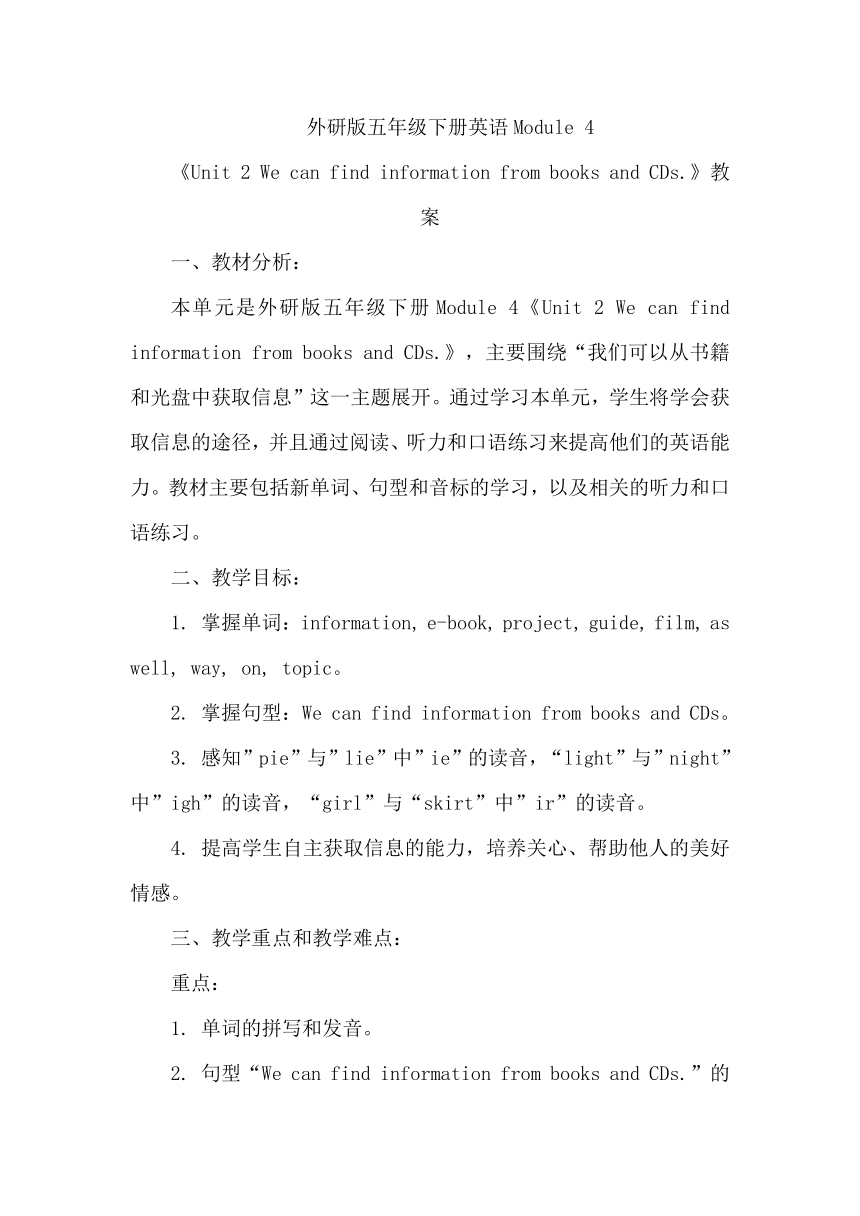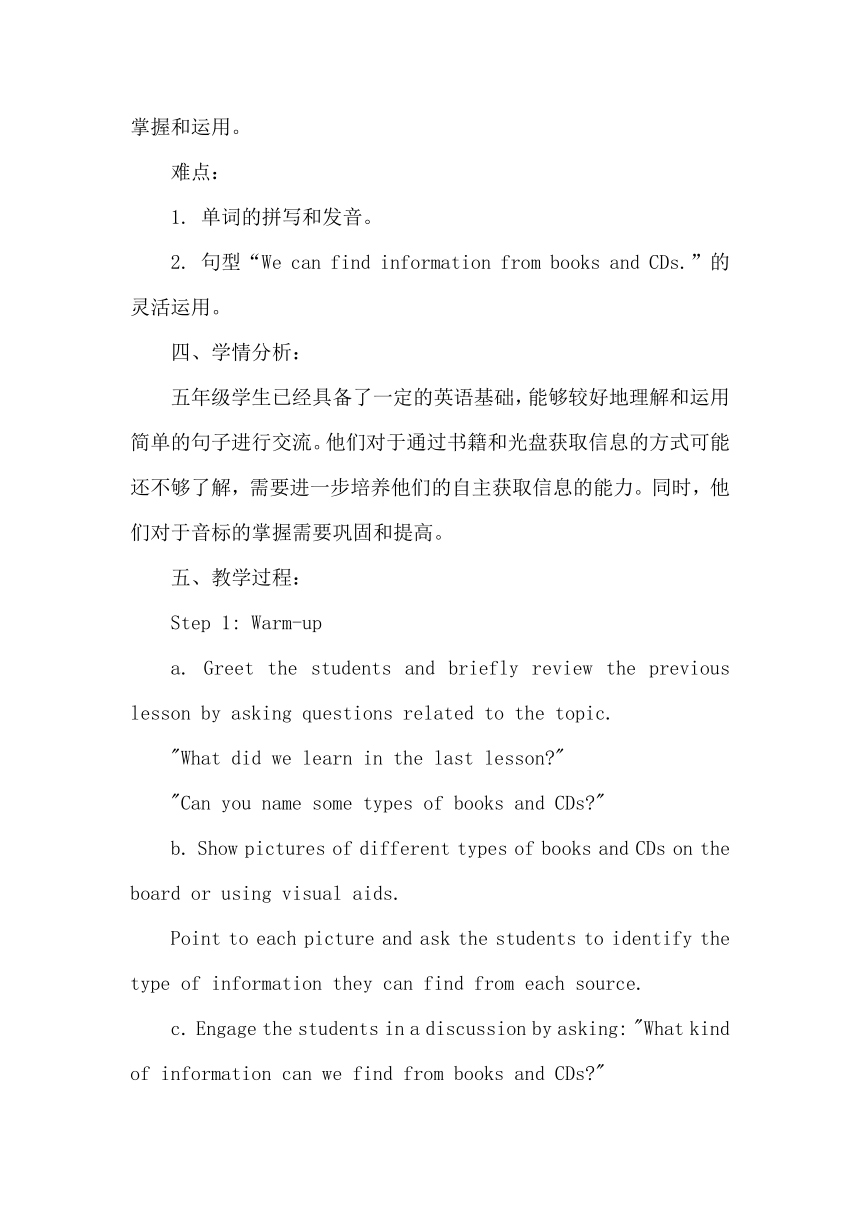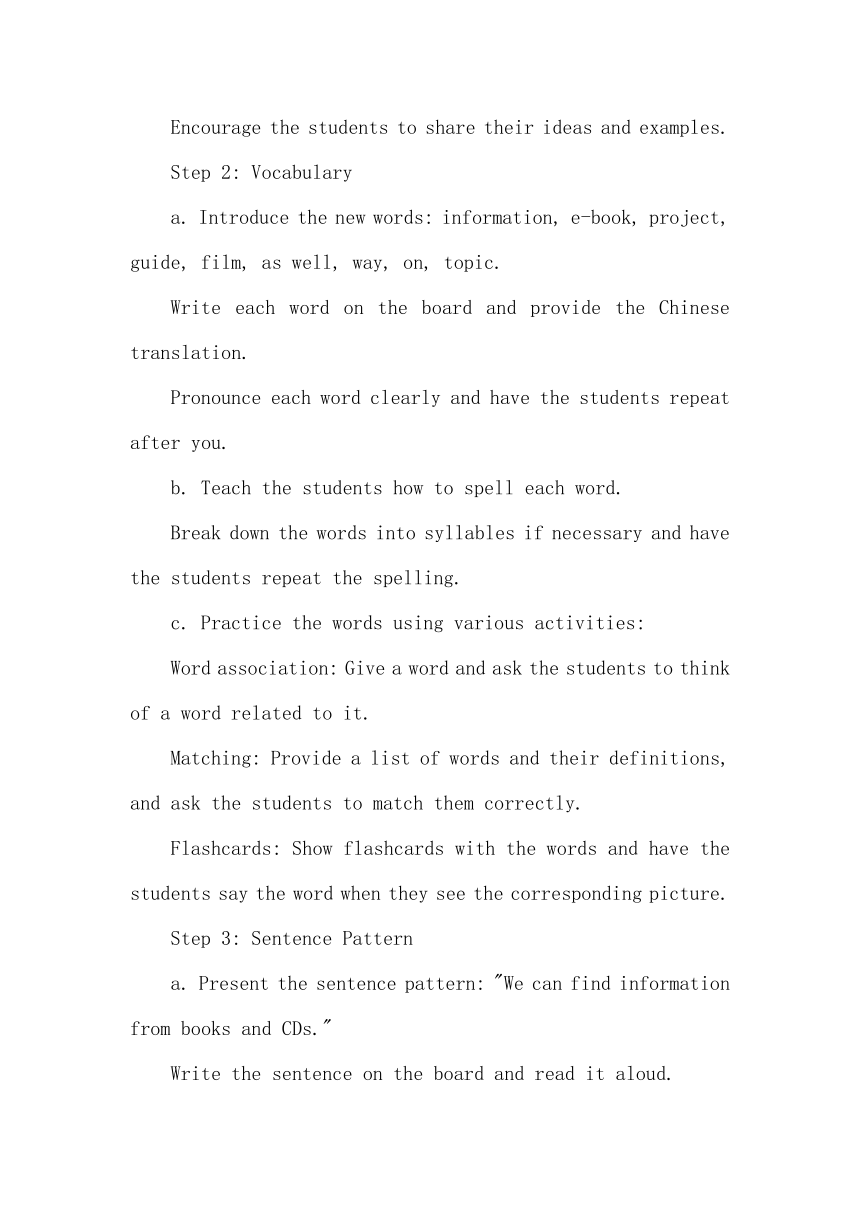Module 4 Unit 2 We can find information from books and CDs.教案
文档属性
| 名称 | Module 4 Unit 2 We can find information from books and CDs.教案 |

|
|
| 格式 | docx | ||
| 文件大小 | 14.6KB | ||
| 资源类型 | 教案 | ||
| 版本资源 | 外研版(三年级起点) | ||
| 科目 | 英语 | ||
| 更新时间 | 2024-03-24 16:50:10 | ||
图片预览




文档简介
外研版五年级下册英语Module 4
《Unit 2 We can find information from books and CDs.》教案
一、教材分析:
本单元是外研版五年级下册Module 4《Unit 2 We can find information from books and CDs.》,主要围绕“我们可以从书籍和光盘中获取信息”这一主题展开。通过学习本单元,学生将学会获取信息的途径,并且通过阅读、听力和口语练习来提高他们的英语能力。教材主要包括新单词、句型和音标的学习,以及相关的听力和口语练习。
二、教学目标:
1. 掌握单词:information, e-book, project, guide, film, as well, way, on, topic。
2. 掌握句型:We can find information from books and CDs。
3. 感知”pie”与”lie”中”ie”的读音,“light”与”night”中”igh”的读音,“girl”与“skirt”中”ir”的读音。
4. 提高学生自主获取信息的能力,培养关心、帮助他人的美好情感。
三、教学重点和教学难点:
重点:
1. 单词的拼写和发音。
2. 句型“We can find information from books and CDs.”的掌握和运用。
难点:
1. 单词的拼写和发音。
2. 句型“We can find information from books and CDs.”的灵活运用。
四、学情分析:
五年级学生已经具备了一定的英语基础,能够较好地理解和运用简单的句子进行交流。他们对于通过书籍和光盘获取信息的方式可能还不够了解,需要进一步培养他们的自主获取信息的能力。同时,他们对于音标的掌握需要巩固和提高。
五、教学过程:
Step 1: Warm-up
a. Greet the students and briefly review the previous lesson by asking questions related to the topic.
"What did we learn in the last lesson "
"Can you name some types of books and CDs "
b. Show pictures of different types of books and CDs on the board or using visual aids.
Point to each picture and ask the students to identify the type of information they can find from each source.
c. Engage the students in a discussion by asking: "What kind of information can we find from books and CDs "
Encourage the students to share their ideas and examples.
Step 2: Vocabulary
a. Introduce the new words: information, e-book, project, guide, film, as well, way, on, topic.
Write each word on the board and provide the Chinese translation.
Pronounce each word clearly and have the students repeat after you.
b. Teach the students how to spell each word.
Break down the words into syllables if necessary and have the students repeat the spelling.
c. Practice the words using various activities:
Word association: Give a word and ask the students to think of a word related to it.
Matching: Provide a list of words and their definitions, and ask the students to match them correctly.
Flashcards: Show flashcards with the words and have the students say the word when they see the corresponding picture.
Step 3: Sentence Pattern
a. Present the sentence pattern: "We can find information from books and CDs."
Write the sentence on the board and read it aloud.
Explain that this sentence means we can obtain knowledge or learn things by reading books or using CDs.
b. Provide examples using the sentence pattern:
"We can find information about animals from books and CDs."
"We can find information about history from books and CDs."
c. Engage the students in a conversation using the sentence pattern:
Ask the students questions like: "Where can we find information about famous people "
Encourage them to respond using the sentence pattern: "We can find information about famous people from books and CDs."
Step 4: Phonics
a. Focus on the pronunciation of the target phonemes: "ie" in "pie" and "lie," "igh" in "light" and "night," and "ir" in "girl" and "skirt."
Write the target words on the board and underline the target phonemes.
Explain that different combinations of letters can make the same sound in different words.
b. Practice the pronunciation of words containing these phonemes through drills and tongue twisters.
Read out the target words and have the students repeat after you, paying attention to the target phonemes.
Create tongue twisters using words with the target phonemes and have the students practice saying them quickly and accurately.
c. Provide examples and encourage students to identify and pronounce words with the target phonemes.
Show flashcards or write words on the board that contain the target phonemes.
Ask the students to identify the phonemes and practice pronouncing the words.
Step 5: Reading and Listening
a. Provide a short passage or an audio clip related to finding information from books and CDs.
Read the passage aloud or play the audio clip for the students to listen to.
b. Ask comprehension questions to check their understanding:
"What is the passage/audio clip about "
"How can we find information from books and CDs "
c. Discuss the advantages and disadvantages of using books and CDs to find information.
Divide the students into pairs or small groups and ask them to share their ideas.
Have a class discussion and encourage students to express their opinions.
Step 6: Speaking and Writing
a. Divide the students into pairs or small groups.
Assign each group a topic of their choice to discuss and find information about using books or CDs.
b. In their groups, ask the students to discuss the topic and find relevant information from books or CDs.
Encourage them to take turns speaking and actively listen to each other.
c. Have each group present their findings to the class and encourage questions and discussion from other students.
Allow time for other students to ask questions and share their thoughts on the topic.
d. Ask the students to write a short paragraph about what they have learned.
Provide a writing prompt such as: "Write a paragraph about the topic you discussed in your group and the information you found from books or CDs."
Step 7: Wrap-up and Reflection
a. Summarize the key points covered in the lesson, including the vocabulary, sentence pattern, phonics, and the importance of finding information from books and CDs.
b. Ask the studentsto reflect on what they have learned and how they can apply it in their daily lives.
"What new words did you learn today How can you use them "
"How do you think finding information from books and CDs can help you in your studies or personal interests "
六、板书设计:
We can find information from books and CDs.
Vocabulary:
information
e-book
project
guide
film
as well
way
on
topic
Phonics:
"ie" in "pie" and "lie"
"igh" in "light" and "night"
"ir" in "girl" and "skirt"
七、教学反思:
本节课通过多种教学方法和活动,使学生在掌握单词和句型的同时,培养了他们自主获取信息的能力和关心、帮助他人的美好情感。学生通过阅读、听力、口语和写作等综合训练,提高了他们的英语能力,并且能够运用所学知识进行交流和探索。在教学过程中,教师注重培养学生的合作意识和思维能力,鼓励学生积极参与课堂活动,提高他们的学习兴趣和动力。在评价学生的学习成果时,教师可以通过观察学生的参与度、口语表达能力和书面作业完成情况等方面来进行评估,并给予及时的反馈和指导。通过不断调整和改进教学策略,可以进一步提高教学效果,促进学生的全面发展。
《Unit 2 We can find information from books and CDs.》教案
一、教材分析:
本单元是外研版五年级下册Module 4《Unit 2 We can find information from books and CDs.》,主要围绕“我们可以从书籍和光盘中获取信息”这一主题展开。通过学习本单元,学生将学会获取信息的途径,并且通过阅读、听力和口语练习来提高他们的英语能力。教材主要包括新单词、句型和音标的学习,以及相关的听力和口语练习。
二、教学目标:
1. 掌握单词:information, e-book, project, guide, film, as well, way, on, topic。
2. 掌握句型:We can find information from books and CDs。
3. 感知”pie”与”lie”中”ie”的读音,“light”与”night”中”igh”的读音,“girl”与“skirt”中”ir”的读音。
4. 提高学生自主获取信息的能力,培养关心、帮助他人的美好情感。
三、教学重点和教学难点:
重点:
1. 单词的拼写和发音。
2. 句型“We can find information from books and CDs.”的掌握和运用。
难点:
1. 单词的拼写和发音。
2. 句型“We can find information from books and CDs.”的灵活运用。
四、学情分析:
五年级学生已经具备了一定的英语基础,能够较好地理解和运用简单的句子进行交流。他们对于通过书籍和光盘获取信息的方式可能还不够了解,需要进一步培养他们的自主获取信息的能力。同时,他们对于音标的掌握需要巩固和提高。
五、教学过程:
Step 1: Warm-up
a. Greet the students and briefly review the previous lesson by asking questions related to the topic.
"What did we learn in the last lesson "
"Can you name some types of books and CDs "
b. Show pictures of different types of books and CDs on the board or using visual aids.
Point to each picture and ask the students to identify the type of information they can find from each source.
c. Engage the students in a discussion by asking: "What kind of information can we find from books and CDs "
Encourage the students to share their ideas and examples.
Step 2: Vocabulary
a. Introduce the new words: information, e-book, project, guide, film, as well, way, on, topic.
Write each word on the board and provide the Chinese translation.
Pronounce each word clearly and have the students repeat after you.
b. Teach the students how to spell each word.
Break down the words into syllables if necessary and have the students repeat the spelling.
c. Practice the words using various activities:
Word association: Give a word and ask the students to think of a word related to it.
Matching: Provide a list of words and their definitions, and ask the students to match them correctly.
Flashcards: Show flashcards with the words and have the students say the word when they see the corresponding picture.
Step 3: Sentence Pattern
a. Present the sentence pattern: "We can find information from books and CDs."
Write the sentence on the board and read it aloud.
Explain that this sentence means we can obtain knowledge or learn things by reading books or using CDs.
b. Provide examples using the sentence pattern:
"We can find information about animals from books and CDs."
"We can find information about history from books and CDs."
c. Engage the students in a conversation using the sentence pattern:
Ask the students questions like: "Where can we find information about famous people "
Encourage them to respond using the sentence pattern: "We can find information about famous people from books and CDs."
Step 4: Phonics
a. Focus on the pronunciation of the target phonemes: "ie" in "pie" and "lie," "igh" in "light" and "night," and "ir" in "girl" and "skirt."
Write the target words on the board and underline the target phonemes.
Explain that different combinations of letters can make the same sound in different words.
b. Practice the pronunciation of words containing these phonemes through drills and tongue twisters.
Read out the target words and have the students repeat after you, paying attention to the target phonemes.
Create tongue twisters using words with the target phonemes and have the students practice saying them quickly and accurately.
c. Provide examples and encourage students to identify and pronounce words with the target phonemes.
Show flashcards or write words on the board that contain the target phonemes.
Ask the students to identify the phonemes and practice pronouncing the words.
Step 5: Reading and Listening
a. Provide a short passage or an audio clip related to finding information from books and CDs.
Read the passage aloud or play the audio clip for the students to listen to.
b. Ask comprehension questions to check their understanding:
"What is the passage/audio clip about "
"How can we find information from books and CDs "
c. Discuss the advantages and disadvantages of using books and CDs to find information.
Divide the students into pairs or small groups and ask them to share their ideas.
Have a class discussion and encourage students to express their opinions.
Step 6: Speaking and Writing
a. Divide the students into pairs or small groups.
Assign each group a topic of their choice to discuss and find information about using books or CDs.
b. In their groups, ask the students to discuss the topic and find relevant information from books or CDs.
Encourage them to take turns speaking and actively listen to each other.
c. Have each group present their findings to the class and encourage questions and discussion from other students.
Allow time for other students to ask questions and share their thoughts on the topic.
d. Ask the students to write a short paragraph about what they have learned.
Provide a writing prompt such as: "Write a paragraph about the topic you discussed in your group and the information you found from books or CDs."
Step 7: Wrap-up and Reflection
a. Summarize the key points covered in the lesson, including the vocabulary, sentence pattern, phonics, and the importance of finding information from books and CDs.
b. Ask the studentsto reflect on what they have learned and how they can apply it in their daily lives.
"What new words did you learn today How can you use them "
"How do you think finding information from books and CDs can help you in your studies or personal interests "
六、板书设计:
We can find information from books and CDs.
Vocabulary:
information
e-book
project
guide
film
as well
way
on
topic
Phonics:
"ie" in "pie" and "lie"
"igh" in "light" and "night"
"ir" in "girl" and "skirt"
七、教学反思:
本节课通过多种教学方法和活动,使学生在掌握单词和句型的同时,培养了他们自主获取信息的能力和关心、帮助他人的美好情感。学生通过阅读、听力、口语和写作等综合训练,提高了他们的英语能力,并且能够运用所学知识进行交流和探索。在教学过程中,教师注重培养学生的合作意识和思维能力,鼓励学生积极参与课堂活动,提高他们的学习兴趣和动力。在评价学生的学习成果时,教师可以通过观察学生的参与度、口语表达能力和书面作业完成情况等方面来进行评估,并给予及时的反馈和指导。通过不断调整和改进教学策略,可以进一步提高教学效果,促进学生的全面发展。
同课章节目录
- Module 1
- Unit 1 We lived in a small house.
- Unit 2 She didn't have a television.
- Module 2
- Unit 1 She learnt English.
- Unit 2 Mr Li was a teacher.
- Module 3
- Unit 1 She had eggs and sausages.
- Unit 2 Sam ate four hamburgers.
- Module 4
- Unit 1 Let's make a home library.
- Unit 2 We can find information from books and CDs.
- Module 5
- Unit 1 It's big and light.
- Unit 2 It's too big for you.
- Module 6
- Unit 1 I went there last year.
- Unit 2 She visited the Tianchi Lake.
- Module 7
- Unit 1 My father goes to work at eight o'clock eve
- Unit 2 I'll be home at seven o'clock.
- Module 8
- Unit 1 Will you help me?
- Unit 2 I made a kite.
- Module 9
- Unit 1 We laughed a lot.
- Unit 2 Mum bought new T-shirts for you.
- Module 10
- Unit 1 Where are you going to go?
- Unit 2 I'm in New York now.
- Review Module
- Unit 1
- Unit 2
